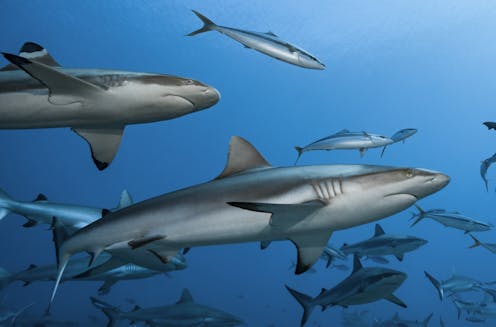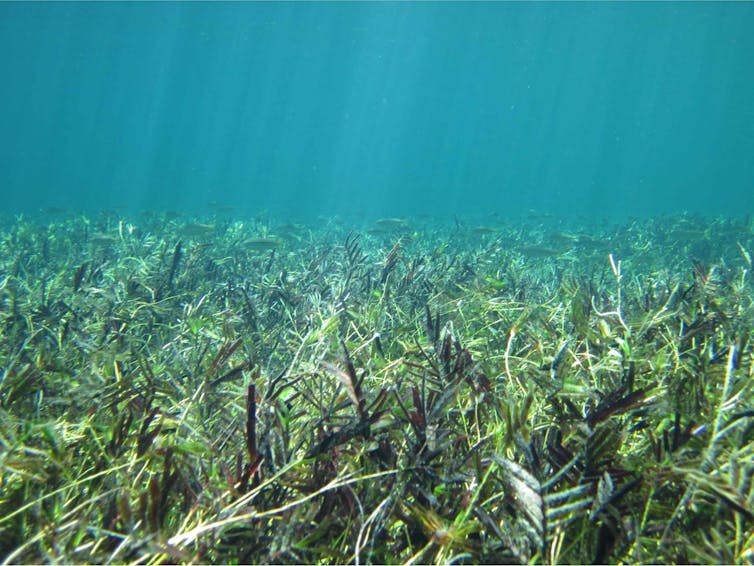
There are more than 500 species of sharks in the world’s oceans, from the 7-inch dwarf lantern shark to whale sharks that can grow to over 35 feet long. They’re found from polar waters to the equator, at the water’s surface and miles deep, in the open ocean, along coasts and even in some coastal rivers.
With such diversity, it’s no surprise that sharks serve many ecological functions. For example, the largest individuals of some big predatory species, such as tiger and white sharks, can have an oversized role in maintaining balances among species. They do this by feeding on prey and sometimes by just being present and scary enough that prey species change their habits and locations.
In a newly published study, colleagues and I surveyed decades of research on sharks’ ecological roles and considered their future in oceans dominated by people. We found that because sharks play such diverse and sometimes important functions in maintaining healthy oceans, their current decline is an urgent problem. Since 1970, global populations of sharks and rays have decreased by more than 70%.
People are killing many types of sharks at unsustainable rates, mainly through overfishing. We see a need for nations to rethink where and how to conserve sharks for healthy oceans.
How sharks foster seagrasses
Along the remote coast of Western Australia, more than two decades of work shows that the mere presence of tiger sharks shapes the entire seagrass ecosystem by changing where and how big grazers, such as sea turtles and sea cows, feed.
Having tiger sharks nearby protects wide swaths of seagrass from being overgrazed, allowing it to grow into thick underwater meadows that provide habitat for juvenile fish and shellfish. These species are important food for other animals and for humans.


In places where tiger sharks have declined and turtle populations have expanded, seagrasses are being overgrazed. In Bermuda, for example, the exploding turtle population has led to an almost total collapse of seagrasses.
White sharks produce some of the same effects. Along the California coast, where white shark numbers are increasing, otters are spending more time in the safety of protected inland waters and less time in the open waters of Monterey Bay. The otters prey on crabs, which in turn feed on grazing invertebrates such as sea slugs that clean algae from seagrasses. More otters means fewer crabs, more grazers and healthier seagrasses.
Kelp forests and reefs
Kelp forests are dense stands of large brown algae that grow in shallow zones near coasts. Along the U.S. West Coast, overhunting drove local populations of sea otters to extinction by the early 1900s. This caused huge kelp forest losses by allowing sea urchins – a favorite food of otters – to spread and consume kelp.
Over the past 50 years, otter populations have rebounded with federal protection. But as white sharks expand their ranges northward, they are preventing otters from expanding their range because there aren’t kelp forests for the otters to hide in.
The otters will likely expand their ranges only once kelp forests become established. This complicates restoration efforts, since otters won’t be removing enough urchins for kelp to become established.
When sharks are present near coral reefs, fish avoid the sharks by sticking close to the safety of the reef. This reduces grazing on seagrasses and algae across wide areas. There is still much to learn, however, about when, where and how sharks might be important for coral reef health.
Food and nutrient sources
Sharks can also be prey. Some, including large species like white sharks, are important food sources for some killer whale populations around the world. Smaller sharks, including blacktip sharks, can be key menu items for larger sharks, such as great hammerheads.
As sharks consume prey in one place and excrete waste elsewhere, they move nutrients throughout the ocean. In the Pacific, for example, gray reef sharks move nitrogen from the offshore waters where they feed to the coral reefs where they spend their days, providing important fertilizer for ocean food webs.
In Florida’s coastal waters, young bull sharks feed during brief visits to the ocean, then return to safer, nearly freshwater rivers, where they spend most of their time and release nutrients in their waste.
Sometimes sharks’ presence helps other fish. In the open ocean, sharks’ rough scales make perfect scratching posts for fish to remove parasites.
Protecting sharks’ roles
Our review makes clear that sharks play diverse roles in maintaining healthy oceans. We see important implications for shark conservation.
Step 1 would be to set goals beyond simply ensuring that there are sharks in the oceans and to target species that have key ecological roles.
Within populations, it is important to protect certain types of individual sharks. For example, the largest tiger sharks are the ones that shape the behavior of turtles and sea cows, benefiting seagrass ecosystems. Intensive fishing worldwide makes it extremely challenging for large sharks that can live for decades or even centuries to survive and grow to ecologically important sizes.
Working with local communities in coastal areas could build support for protecting these large ocean predators, much as conservationists are working on land to protect iconic predators such as wolves. Nations could build networks of large protected areas that forbid shark fishing, focusing on key areas where individual sharks may roam.
Research shows that sharks benefit from creating protected areas, limiting shark catch outside these zones and restricting use of fishing gear that does the most harm to sharks, such as gill nets and longlines. With a clearer understanding of sharks’ ecological value, my colleagues and I hope to see focused action at all levels to protect these essential animals.
Michael Heithaus receives funding from the Shark Conservation Fund and the National Science Foundation.
This article was originally published on The Conversation. Read the original article.







